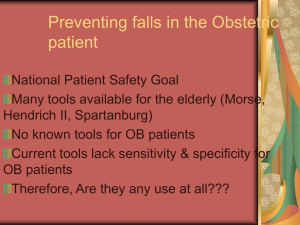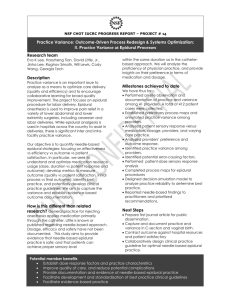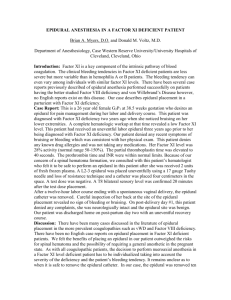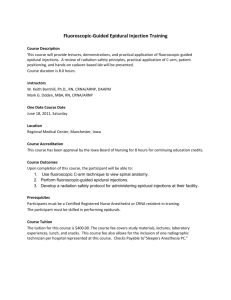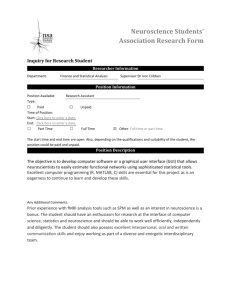An Epidural Hemorrhage
advertisement
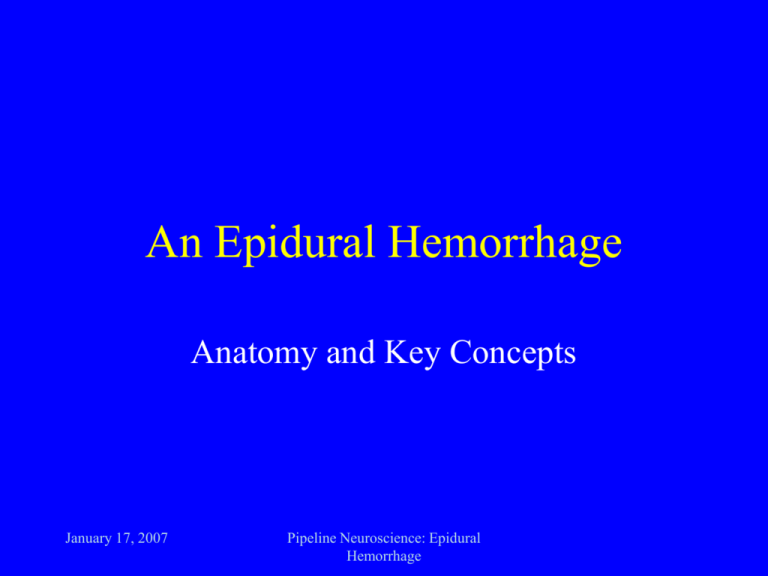
An Epidural Hemorrhage Anatomy and Key Concepts January 17, 2007 Pipeline Neuroscience: Epidural Hemorrhage Anatomy of an Epidural Bleed January 17, 2007 Pipeline Neuroscience: Epidural Hemorrhage Anatomy of an Epidural Bleed • The middle meningeal artery runs directly below the temporal bone of the face • If the temporal bone is fractured by a blow to the face, the middle meningeal may be lacerated. • If this happens, the artery bleeds into what is called the epidural space. January 17, 2007 Pipeline Neuroscience: Epidural Hemorrhage Anatomy of an Epidural Bleed: The Meninges • Three membranes (the meninges) envelop the brain and spinal cord: pia, arachnoid, and dura January 17, 2007 Pipeline Neuroscience: Epidural Hemorrhage Meningeal Anatomy January 17, 2007 Pipeline Neuroscience: Epidural Hemorrhage • Anatomy of an Epidural Bleed: Spaces and Potential Spaces in the CNS The epidural space: – the space between the dura (the outermost membrane covering the brain and spinal cord) and skull, or the bony vertebrae that form the spinal canal. In the spine, the epidural space contains lymphatics, small arteries, and the epidural venous plexus. In the brain the epidural space is a potential space, meaning that the space does not exist under normal conditions. • The subdural space: – The space between the dura mater and the arachnoid mater, this is a potential space in both the skull and the spine. • The subarachnoid space: – between the arachnoid mater and the pia mater, this space contains the cerebrospinal fluid January 17, 2007 Pipeline Neuroscience: Epidural Hemorrhage January 17, 2007 Pipeline Neuroscience: Epidural Hemorrhage Concept: Bleeding Into a Closed Space January 17, 2007 Pipeline Neuroscience: Epidural Hemorrhage The “Lucid Interval” • An epidural hemorrhage is often characterized by the following sequence of events: – Blunt trauma/ a blow to the head, followed by: – 1) Initial confusion, decreased consciousness, or loss of consciousness – 2) A “lucid interval” (20-50%): • a brief period of full conciousness/restored mental status. The patient seems back to his/her “normal self.” – 3) Change in mental status +/- unstable vital signs (blood pressure, heart rate): • the patient becomes confused, somnolent (sleepy), may have neurologic signs such as hemiparesis, one dilated pupil, may become comatose. January 17, 2007 Pipeline Neuroscience: Epidural Hemorrhage Cushing’s Response • Body’s response to increased intracranial pressure (ICP): – Increase in blood pressure (Hypertension) – Decrease in heart rate (Bradycardia) – Altered respiratory rate • ICP can compress blood vessels in the brain, block off oxygen delivery (ischemia), and put pressure on the brainstem. January 17, 2007 Pipeline Neuroscience: Epidural Hemorrhage Cushing’s Response Hypertension Bradycardia Respiratory Rate January 17, 2007 Pipeline Neuroscience: Epidural Hemorrhage The “Blown” Pupil January 17, 2007 Pipeline Neuroscience: Epidural Hemorrhage The Motor “Homunculus” January 17, 2007 Pipeline Neuroscience: Epidural Hemorrhage January 17, 2007 Pipeline Neuroscience: Epidural Hemorrhage
